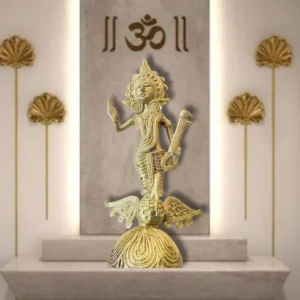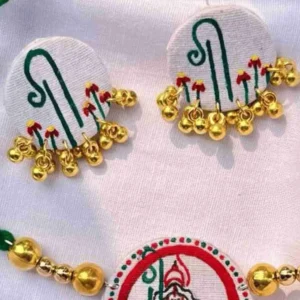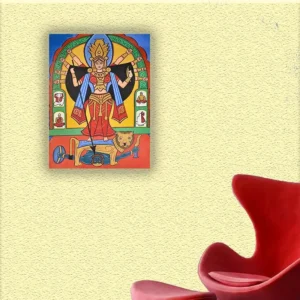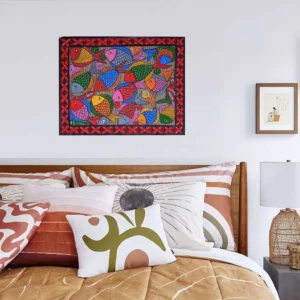Trailing Dhokra Art History
Dhokra Art is made from a historic metal casting technique called lost wax casting. The technique was used thousands of years back to cast non-ferrous metals like copper to make artifacts. Some old artisans also used alloys like brass or bronze. Brass is a mixture of zinc and copper, while bronze is an alloy of tin and copper. About the artisans
The name of this unusual and attractive art form is named after ‘Dhokar Damar,’ a nomadic Indian tribe belonging to the eastern part of the country. The tribe initially resided in the Bankura-Dariapur belt in West Bengal, parts of Madhya Pradesh, and Odisha. Historians believe that the custodian of this legacy is mainly the tribal communities living in this region and famously known as Dhokra art of West Bengal.
Interestingly, this prized Indian art is not limited to only one region of the country. It is believed that the artisans might have travelled from one part to the other and carried with them the knowledge and skills of Dhokra and passed it from one generation to the other.
As a result, the tribal community that was primarily into making Dhokra Art and lived in the region covering Birbhum, Purulia, Burdwan, and Midnapore is now spread to the neighboring regions too, having evolved this legacy to include local aspects and interpretations.
Today the tribe lives across the entire eastern belt of India, stretching from Jharkhand to Chattisgarh to Telangana to West Bengal and Odisha. There are reasons to believe that some of the oldest tribes in India, like the Gonds in Madhya Pradesh and Bhils occupying regions like Rajasthan, Western Maharashtra, western Madhya Pradesh, and southeastern Gujarat, have been practicing this folk art for ages. The art form is also, therefore, popularly known as Dhokra art of Jharkhand and Dhokra art of Chattisgarh.
Another region that is known for its rich contribution to this art is Bastar in Chattisgarh. In fact, the Bastar Dhokra Art has its own name and claim to fame, not just in the domestic market but internationally too. The ethnic designs of this art were earlier available only in the local weekly markets in the region.
The Process of making Dhokra art
The tribals make this folk art using the ancient methods and techniques they have learned from their ancestors. Dating back to the Age of Metallurgy, the process typically involves extracting metal from minerals, almost the way it was done about 4,000 years back.
The technique is based on annealing, where the metal extract is heated to reach extremely high temperatures to melt. It is then filled in the pre-casted molds, where the metal is allowed to cool and take the shape of the mold. The mold preparation involves great work of artistry and is not as easy as it may sound, or pieces of the art may appear.
The technique itself has undergone a tremendous transformation from the primitive age to the medieval era. Originally, the clay model or the mold was made of wax, but later it got replaced with metallic ores and alloys, basically bronze and brass.
There are two kinds of processes used for making the cast – hollow casting, which is the conventional method, and solid casting, which is the modern interpretation. While the former method is mostly used in the central and eastern parts of the country, the latter is used primarily in the southern parts of India, like Telangana.
The process involves creating a core clay model first. The materials used for making the model are usually riverbed clay. Sometimes the model is made from the local soil that is mixed with rice husk and coal dust. Once the clay model is made, a mixture made from beehive wad, a resin derived from trees like Dammar gum tree, and melted tar is inserted in the discs in the shape of strings that are made manually.
Decorations, too, are made on the Dhokra piece by hand. Originally, beehive wax was used; today, candle and paraffin wax are also used. Another change is that some artisans do not make the strings manually anymore; they use a metallic and wooden press to do so.
In the solid casting method, instead of the clay core, a solid wax core is made. There is a funnel on the top of the wax or clay core with an opening through which scrap metal pieces are inserted.
These pieces are then melted through a firing process inside the mold. The process is called annealing. In the hollow-casting model, the clay cast is covered with jute, sand, and soil and dried in the Sun. When the metal cools down, the cast is removed, and through a demoulding process, the metal dhokra handicrafts are obtained.
Dhokra Art is a part of our cultural heritage. While it is an individual choice to encourage local and folk art, it is important to understand that our rich past is our legacy and should not fade away or die down. There are tribals in Indian villages that spend all their waking hours creating unique handicrafts using their hands, doing their best to keep the ancient art alive.
The governments are doing their bit; we can do the rest. These art forms look amazing pieces as home décor items and can adorn your home wonderfully well. Bring home a handmade piece of Dhokra art to help a tribal family in its endeavor to maintain the essence of the artwork
Final Thoughts
The Dhokra handicrafts form in India holds a rich cultural and historical significance. With its origins dating back thousands of years, this traditional craft has not only survived but thrived, showcasing the skill and creativity of Indian artisans. The unique dhokra casting technique, using the lost wax process, adds a distinctive charm to each Dokhra artwork, making it highly sought after by art enthusiasts and collectors worldwide.
As an art form deeply rooted in Indian folklore, Dhokra reflects the traditions and beliefs of the local communities, offering a glimpse into the cultural tapestry of the country. With its timeless beauty and enduring legacy, Dhokra art continues to captivate and inspire, ensuring its preservation for generations to come.





